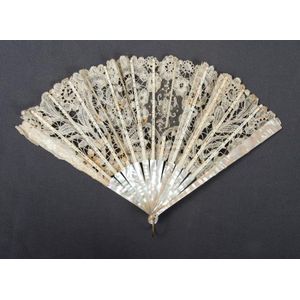Qing Dynasty Ivory and Feather Fan
You must be a subscriber, and be logged in to view price and dealer details.
Subscribe Now to view actual auction price for this item
When you subscribe, you have the option of setting the currency in which to display prices to $Au, $US, $NZ or Stg.
- Qing Dynasty - The Qing Dynasty was the last imperial dynasty of China, ruling from 1644 to 1912. It was established by the Manchu people, who originated from the northeastern region of China. The Qing Dynasty was preceded by the Ming Dynasty and followed by the Republic of China.
- Ivory - Ivory is a hard white material that comes from the tusks of elephants, mammoth, walrus and boar, or from the teeth of hippopotamus and whales. The ivory from the African elephant is the most prized source of ivory. Although the mammoth is extinct, tusks are still being unearthed in Russia and offered for sale.
Ivory has been used since the earliest times as a material for sculpture of small items, both in Europe and the east, principally China and Japan.
In Asia ivory has been carved for netsuke, seals, okimono, card cases, fan supports, animals and other figures and even as carved tusks.
In the last 200 years in Europe ivory has been used to carve figures, for elaborate tankards, snuff boxes, cane handles, embroidery and sewing accessories, in jewellery and as inlay on furniture. Its more practical uses include being used for billiard balls, buttons, and a veneers on the top of piano keys.
The use and trade of elephant ivory have become controversial because they have contributed to Due to the decline in elephant populations because of the trade in ivory, the Asian elephant was placed on Appendix One of the Convention on International Trade in Endangered Species (CITES), in 1975, and in January 1990, the African elephant was similarly listed. Under Appendix One, international trade in Asian or African elephant ivory between member countries is forbidden. Unlike trade in elephant tusks, trade in mammoth tusks is legal.
Since the invention of plastics, there have been many attempts to create an artificial ivory
This item has been included into following indexes:
Visually similar items

Victorian mother of pearl folding fan. lady's lace fan with mother of pearl and ivory struts. Losses to three struts. Length 22 cm

Guo Lanxiang (1885 - 1938) and Wei Xiong (19th to 20th century), Summer landscape (1931) and figures among plum trees (1905), ink and colour on paper, signed and inscribed by the artists, with two seals of the artists, 31 cm long. Provenance: NSW private c

A 19th century Canton export ivory and silk fan the outer ivory guard sticks carved in relief opening to reveal a silk interior embroidered with dragon, breaks to both guard ends. 20 cm long

A Chinese ivory brise fan, the 26 sticks and ends finely carved and pierced with delicate patterns. Length 19 cm. Provenance: The Flower Family Collection.
